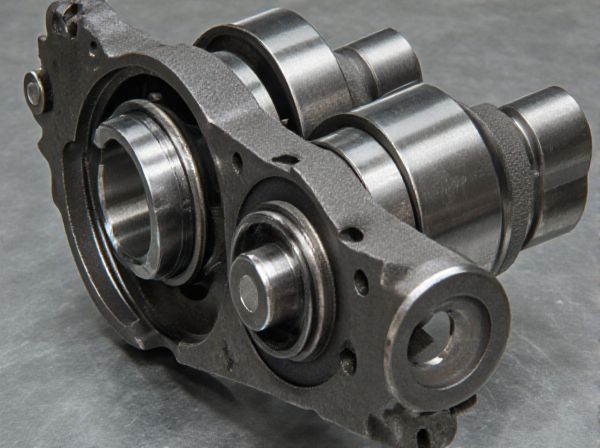
Photo illustration: Flatplane vs Crossplane Crankshaft
Flatplane crankshafts offer a simpler design with evenly spaced firing intervals, resulting in a higher-revving engine and a distinctive exhaust note often found in sports cars. Crossplane crankshafts provide better balance and smoother power delivery by offsetting crank pins, enhancing torque and reducing vibrations in muscle cars and V8 engines. Your choice depends on whether you prioritize high-rev performance or smooth, consistent power output.
Table of Comparison
| Feature | Flatplane Crankshaft | Crossplane Crankshaft |
|---|---|---|
| Design | Single-plane, 180deg crank throws | Four-plane, 90deg crank throws |
| Engine Type | Common in high-revving inline-4 and V8 engines | Standard in American V8 engines |
| Vibration | Higher secondary vibrations due to design | Smoother with better counterweight balance |
| Sound | Sharp, high-pitched exhaust note | Deep, rumbling exhaust tone |
| Performance | Quicker revving, better throttle response | More torque at lower RPMs |
| Weight | Lighter due to simpler construction | Heavier because of added counterweights |
| Cost | Generally cheaper to produce | More expensive due to complexity |
Introduction to Crankshaft Types
Flatplane and crossplane crankshafts differ primarily in their design and firing intervals, affecting engine performance and sound. Flatplane crankshafts feature evenly spaced crank throws aligned in a single plane, resulting in quicker throttle response and higher-revving capability, commonly found in high-performance sports cars. Crossplane crankshafts arrange crank throws at 90-degree intervals, producing smoother power delivery and reduced vibration, typically used in V8 engines for improved balance and torque.
What is a Flatplane Crankshaft?
A flatplane crankshaft features evenly spaced crankpins positioned at 180-degree intervals, creating a flat, inline arrangement that enhances exhaust pulse timing and engine responsiveness. Commonly found in high-performance inline-four and V8 engines, flatplane designs reduce rotational inertia, allowing for quicker revving and improved throttle response. The configuration delivers a distinct exhaust note and can improve power output, but may introduce increased vibration compared to crossplane crankshafts.
What is a Crossplane Crankshaft?
A crossplane crankshaft features crankpins positioned at 90-degree intervals, creating a distinct firing order that enhances engine balance and reduces vibrations in V8 engines. This design improves torque delivery and exhaust scavenging, resulting in a smoother and more responsive driving experience. Compared to flatplane crankshafts, crossplane cranks offer better low-end torque and refined sound characteristics favored in muscle cars and luxury performance vehicles.
Key Mechanical Differences
Flatplane crankshafts feature a 180-degree firing order with crankpins aligned in a flat, planar layout, resulting in a lighter rotating assembly and higher revving capabilities. Crossplane crankshafts have a 90-degree offset between crankpins, producing smoother power delivery and reduced vibrations due to better primary and secondary balance. The mechanical distinction affects engine sound, torque characteristics, and overall performance dynamics, with flatplane commonly used in high-performance sports cars and crossplane favored in muscle cars and V8 engines for refinement.
Performance Characteristics
Flatplane crankshafts offer quicker throttle response and higher revving capabilities due to their reduced rotational inertia and less counterweight mass, making them ideal for high-performance sports cars. Crossplane crankshafts provide smoother power delivery and reduced vibration by balancing the firing intervals, which enhances torque at lower RPMs and improves drivability in muscle cars and cruisers. The trade-off between flatplane and crossplane designs centers on choosing between sharp engine responsiveness and refined engine smoothness without sacrificing power output.
Sound and Vibration Comparison
Flatplane crankshafts produce a higher-pitched, sharper exhaust note due to their even firing intervals, creating a distinctive sound often associated with sports cars and exotic engines. In contrast, crossplane crankshafts generate a deeper, rumbling exhaust tone with uneven firing intervals that contribute to smoother vibration characteristics and enhanced low-end torque. Vibration analysis shows flatplane designs transmit more engine vibrations to the chassis, while crossplane setups effectively reduce vibration through better inherent balance and counterweights.
Applications in Automotive Engines
Flatplane crankshafts, commonly used in high-performance sports cars and exotic vehicles like the Ferrari 458 Italia and Porsche 911 GT3, offer quicker throttle response and higher RPM capabilities ideal for naturally aspirated engines. Crossplane crankshafts, predominantly found in American muscle cars such as the Ford Mustang GT and Chevrolet Camaro SS, enhance low-end torque and produce a smoother idle, benefiting V8 engines tuned for everyday driving and muscle car appeal. Engine designers select flatplane or crossplane configurations based on targeted power delivery characteristics, sound profile, and intended vehicle performance requirements.
Advantages of Flatplane Crankshafts
Flatplane crankshafts offer reduced rotational inertia, allowing engines to achieve higher RPMs and deliver quicker throttle response compared to crossplane designs. Their simplified construction leads to lighter weight, improving the overall power-to-weight ratio and enhancing vehicle agility. Moreover, flatplane cranks produce a more balanced exhaust pulse, which can optimize scavenging and boost engine efficiency in performance applications.
Advantages of Crossplane Crankshafts
Crossplane crankshafts offer superior torque delivery and improved engine balance compared to flatplane designs, which enhances smoothness and reduces vibrations in V8 engines. Their unique 90-degree crankpin arrangement promotes better exhaust scavenging and contributes to a distinctive sound favored in muscle and performance cars. This design also supports greater durability and reliability under high loads, making crossplane crankshafts ideal for powerful, street-driven vehicles.
Which Crankshaft is Better for You?
Choosing between a flatplane and crossplane crankshaft depends on your performance needs and engine characteristics. Flatplane crankshafts offer quicker revving and higher RPM potential, ideal for sports cars seeking agility and responsiveness. Crossplane crankshafts provide smoother power delivery with better torque at low RPMs, making them suitable for muscle cars and street performance where drivability and engine sound are priorities.
 caratoz.com
caratoz.com